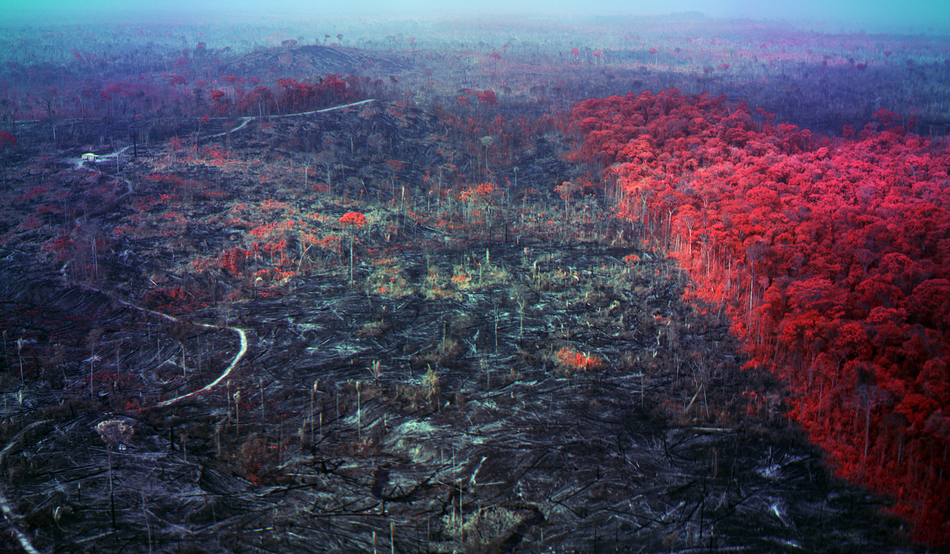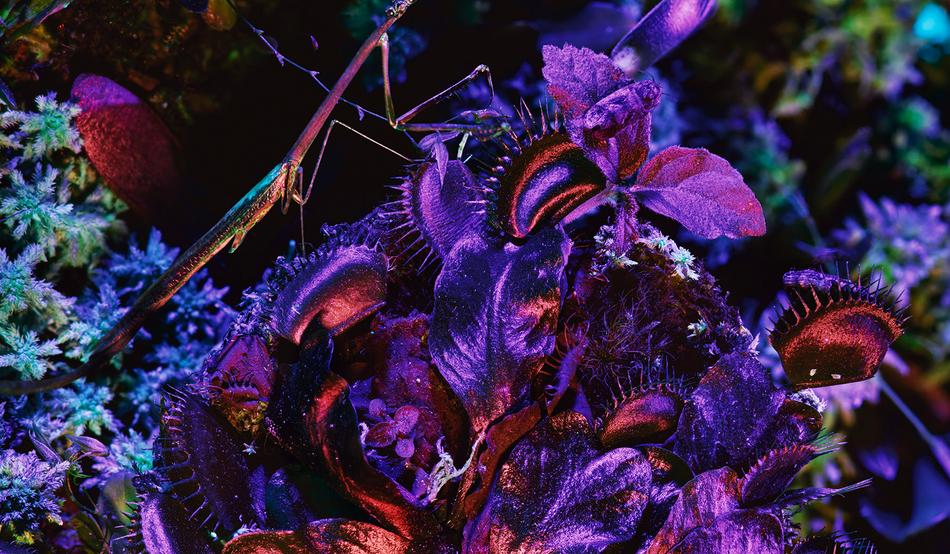On the roads of Belém, the gateway to the Amazon, Richard Mosse encountered a group dressed in yellow t-shirts trying to stop traffic. It was three months after Jair Bolsonaro had lost the Brazilian election, but these were his supporters. “What were they still doing there?” Mosse asked himself at the time. A few days later, as Bolsonaristas trashed the country’s capital, he found his answer: “Those were the people who got on buses and went down to Brasília.”
Brazil has occupied much of Mosse’s time and energy over the past few years, and is now the extensive subject of his latest photography exhibition at 180 the Strand, Broken Spectre, now extended until 26th February.
The Irish photographer, who was raised in a Quaker family in rural County Kilkenny, first gained international attention when his film documenting the civil war in the Congo, The Enclave, was selected to represent Ireland at the 2013 Venice Biennale. At the Barbican in 2017 he then exhibited an off shoot of Heat Maps, which showed the perilous lives of refugees living in camps across Europe, north Africa and the Middle East. In this latest work at the Strand, he has turned his attention to the Amazon and the catastrophic environmental fallout from decades of ranching, infrastructure development and illegal gold prospecting.
He considers these three most recent works as forming a loose trilogy because, while each is rooted in a specific time and place, they all began with the discovery of a new or unusual film format. “I find the medium first and work backwards,” he says. They “all use different kinds of imaging technologies that can register unseen light.” In the Congo, he used a rare type of 16mm infrared film, first developed in the Second World War but now no longer made, that transformed the verdant African jungle into a vibrant, raspberry pink. In Heat Maps he used a thermographic camera, often used by border control authorities and classified as a weapon under international law, that makes people appear as white phantoms drifting through dark space. What marks out Broken Spectre as a departure is that its imagery is largely the product of scientific rather than military technologies, including “ultraviolet microscopy” and “multispectral geographic information GIS systems”, the latter of which Mosse nonchalantly says he “borrowed” from satellite cameras.
Mosse considers Broken Spectre the more mature work in his loose-knit trilogy, because not only is there interplay between subject and medium but also several different mediums on the same subject. The idea is to capture the climate crisis as it impacts the planet in every scale and aspect: at the micro and the macro, the human and the nonhuman.
The centrepiece of the show is a 70-minute-long video work which flicks between three distinct film formats, accompanied by an original soundtrack by composer Ben Frost. Mosse says that he is asking a lot of his audience by staging such a long film in a gallery setting, but it proves to be an engrossing work. In its dioramic shots—the drone panning over vast swathes of charred rainforest—the infrared lens of the camera transforms the scorched landscape into a rough-hewn beige, like the hide of a wild animal; the red smatterings of trees look like scabs, while pale rivers appear thick and oily. These macro landscapes are cut with microscopic shots of plants taken under fluorescent UV. It is sometimes difficult to tell the difference between the two when shown side-by-side; as the cameras pan over both, only the jittery presence of a large ant or other insect marks out one from the other.
Interspersed between is footage documenting the patchwork of human activity going on within the Amazon, shot in a rare heat-sensitive black and white film. (Mosse reckons only one film in the history of cinema, I Am Cuba from 1964, has ever been shot using it at all.) In one moment, we are trailing behind a trio of vaqueiros (cowboys or ranchers) as the jungle on either side of them falls away into a scorched, deadened clearing. In the next, we watch a young family preparing food at their remote ranch; outside a small boy arranges a set of toy cows in a mini-pen before lassoing one with a piece of string. In another, a group of garimpeiros (illegal gold prospectors) sift a river for fragments of gold. Throughout all of this there is something reminiscent of the very Latin American tradition of the crônica, which attempts to apply literary means to journalistic ends: to astonish and move its audience, but also to inform them.
The Amazon basin may not have been Mosse’s starting point, but his knowledge and enthusiasm for the forest’s history is palpable, even over the phone. He is particularly fascinated by the vaqueiros, who—like the gauchos of the Argentinian pampas—have been mythologised in a way that has made them central to Brazil’s national story, and compounded problematic ideas about the Amazon as an unruly, unconquered frontier. Mosse tells me that, until the 1970s, only 1 per cent of the Amazon rainforest had been lost due to human activity, and much of this through the sustainable activity of rubber tapping. But by that time Brazil’s military dictatorship was curious about neoliberal economic ideas that were emanating from the University of Chicago. “Development” became the regime’s buzzword and the “opening up” of the Amazon a key imperative to that end.
The result was not only the construction of a major new highway cutting through the rainforest from Belém in the state of Pará to the Bolivian border, but the mass movement of people into the area under the auspices of the Instituto Nacional de Colonização e Reforma Agrária—literally, “National Institute for Colonisation and Agrarian Reform”. It was this colonisation that brought a range of stakeholders into the basin, from southern-state cattle ranchers to machismo gold prospectors. By most accounts it has not been a peaceful coexistence, and many of the settlers old and new resent each other. Frequently, disputes over resources end in violence.
Some of the footage in Broken Spectre is of the climate crisis at its most visceral: men cutting down ancient trees or setting areas on fire to create clearings for cattle grazing. Mosse tells me that this made the job of humanising these people even more crucial. “They’re doing terrible things to the environment,” he says. “They’re also people who have to go home to their families and put something on the table, and who have a laugh about life and enjoy life just like you and me.” He doesn’t want to point fingers, “because that lets the viewer off the hook, if they can come out of the room saying: ‘That’s terrible. Those people are bad’… When, actually, we’re all complicit. And that was the biggest challenge of all. To make the audience, the viewer, feel their complicity.”
The film’s most powerful moment is a speech addressed directly to the camera by an indigenous Yanomami woman called Adneia. Between exasperated movements, she laments: “You say you’re here to support us, don’t say that for nothing. We are not here, looking courageous, for no reason, telling you to film us… This is what I ask of you, my friends: don’t film me for nothing.” What makes this more extraordinary is that Mosse had no idea what Adneia was saying to him until long afterwards; he had to have her speech translated first into Portuguese and then English, a process which took nine months. (Lengthy timescales is another recurring theme in Mosse’s process: he spent years building relationships of trust with many of the people filmed.)
The Yanomami territory—in the state Roraima in the north—has been particularly vulnerable to exploitation, owing to the presence of gold there. Since the 1990s garimpeiros have come to set up hydraulic pit mines, creating pools of stagnant water that are fertile breeding grounds for mosquitoes. Adneia’s speech was recorded after a particularly bad rainy reason, during which many children died from malaria. “Bolsonaro, did you put this river here?” Adneia asks. “Were you the creator of this forest? You were not. You did not. And when you send these miners here, your own children, you are a disgrace.”
Things have been moving fast in Brazil in recent months. Bolsonaro is out, despite the kicking and screaming of his yellow-clad supporters in Brasília. Just weeks after they marched on the capital, the new-old president Lula and Sônia Guajajara, the country’s first ever minister for indigenous peoples, visited the Yanomami territory as part of a pledge to tackle what Guajajara called the “humanitarian and health crisis” facing communities like Adneia’s.
Mosse is quietly hopeful that Brazil’s new government can make a difference after the traumatic years of Bolsonaro, yet he is under no illusions about the work that needs to be done—to say nothing of the reckoning due for the destruction already caused. Already, as Mosse points out, the disruption to the Amazon’s ecology caused by deforestation has led to less rainfall. Without rainfall, the rainforest will slowly turn into savannah. And it’s that realisation, after spending some time looking at Mosse’s photographs, that is the most startling: even after all this destruction, we’re still only witnessing the beginning of something much, much bigger.

















